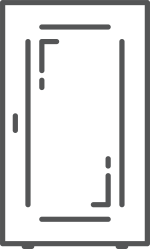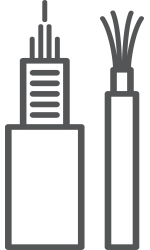Fiber optic cable or twisted pair

Twisted pair and fiber optic cable are the main types of cables used to transmit data in modern networks. Twisted pairs are usually used in local area networks, such as offices, while optical connections are used to transmit data over long distances. In recent years, more and more attention has been paid to outdoor fiber optics, which provide high data transfer rates and resistance to external influences.
Twisted pairs
Twisted pair refers to a cable made up of two or more insulated wires twisted together to diminish electromagnetic interference. Its key benefits include affordability and straightforward installation. This cable type is commonly employed in local area networks, facilitating connections between devices such as computers, routers, and switches.
One variation is the outdoor twisted pair, which is designed to withstand harsh weather conditions, making it suitable for outdoor use. It can also be shielded to protect the signal from external interference. Depending on the requirements, outdoor types can be laid underground or in open environments, depending on the operating conditions.
The materials typically used in the production of twisted pairs are copper or bimetal.
Fiber optic cables
Fiber optic cable transmit data using light signals. This permits a significant increase in the data transfer rate and the distance over which they can be transmitted without signal loss. The main advantage of fiber optic cable compared to twisted pair is its ability to transmit data over significant distances while losing the signal only in very rare cases.
Outdoor fiber optic is specially crafted for external applications, making it suitable for outdoor use. All-weather fiber optic is highly resistant to mechanical damage and weather conditions, making it an ideal solution for installation in difficult conditions. Outdoor fiber optic can also be shielded for additional signal protection.
Ways to install fiber optic cable
Laying fiber optic cable requires a special approach, as it is important to consider not only its physical properties but also environmental conditions. There are various installation methods, including aerial, underground, and sewer techniques.
Aerial installation involves mounting the fiber optic cable on supports or poles. Underground installation is more expensive but also more reliable, as the cable is placed in trenches or special pipelines, protecting it from mechanical damage and climate factors. Sewer installation of fiber optic involves using already existing communication channels, such as sewers, to lay the line.
Using twisted pair and fiber optic cable
Twisted pair, as well as fiber optic cable are broadly implemented in various industries. Twisted pair is often used in local area networks to connect computers, phones and other devices. It provides a fairly high data transfer rate for most applications used in offices and homes.
Fiber optic cable, in turn, is implemented in major networks that require swift and dependable data transmission. Outdoor fiber optics are used to connect various network nodes in cities and intercity connections where high bandwidth and reliability are required.
Conclusion
Twisted pair, fiber optic cable are essential components of modern data transmission networks. Twisted pair is widely used for local connections, while optical connections provide high-speed data transmission over long distances. Depending on the operating conditions, outdoor versions of these cables can be used, which provide additional protection from external factors.


















